To Contact Me


Latest News

Latest News

Latest News

Latest News

Latest News

Latest News

Latest News

Latest News

Latest News


Welcome to VCM-Photography, a website designed and written
by myself Vernon Metcalfe to showcase my photographic passion for
military aviation and wildlife.
My aviation photography is orientated towards the dynamic aspect of military low flying,
where aircraft are captured flying landlocked against the countryside, rather than
airshow photography, where aircraft are captured against the sky.
My parallel passion is wildlife photography, encompassing all species, but with a preference
for the ‘Big Cats’, which has taken me to places such as India, looking for the
elusive tiger, Africa for the lion, leopard and cheetah and to the Brazilian Pantanal for the
iconic jaguar.
 Boeing EA-18G Growler low-level in the Jedi Transition. California, U.S.A.
Boeing EA-18G Growler low-level in the Jedi Transition. California, U.S.A.
 Nkuhuma Pride, lion cub. Sabi Sands, South Africa.
Nkuhuma Pride, lion cub. Sabi Sands, South Africa.
All applicable copyright laws pertain to all content on this site. Downloading, hot‑linking, copying and/or distribution (by print, electronic media or other means) is strictly prohibited. If you wish to purchase high quality images, or use any images for personal or commercial use please email: vcmetcalfe@btinternet.com
Wildlife enthusiasts, photographers and tour guides have been mourning the death of the legendary tigress of Ranthambhore,
T‑84, Arrowhead. The tigress passed away on Thursday 19th June at the age of eleven after a long and difficult
battle with bone cancer.
Arrowhead was born on 2014. Her name was inspired by the distinctive arrow‑shaped mark on her left cheek. She was one
of four cubs in a litter to the tigress T‑19, Krishna, the daughter of the famous T‑16, Machhli. Unfortunately,
one of the cubs was lost, so Arrowhead was raised with her sister T‑83, Lightning and her brother
T‑85, Packman. The father was believed to be the male T‑28, Star Male.
Arrowhead eventually became the dominant tigress of the core Zone 2, 3 and 5, the prime prey areas around the lakes near
Rajbagh and Padam Talab, an area her mother and her famous grandmother T‑16, Machhli once ruled. Arrowhead became internet
famous when a video captured her hunting crocodiles near the lake, a trait unique to tiger behaviour, but a testament to her
hunting skills.
During her life she raised ten cubs across four litters. It was during our first visit to Ranthambhore in March 2019 that my wife
and I had the privilege of a sighting of Arrowhead with her two three‑month‑old cubs from her second litter in Zone 3
of the park. The park authorities would eventually call the cubs T‑124, Riddhi and T‑125, Siddhi.
 Our first sighting of Arrowhead with her two cubs during our visit in March 2019. The cubs would later be named Riddhi and Siddhi.
Our first sighting of Arrowhead with her two cubs during our visit in March 2019. The cubs would later be named Riddhi and Siddhi.
When we visited the park again in March 2020 the two cubs were approximately fifteen months old. Though we found them
both exploring the area on their own they would not become independent from their mother till they were around eighteen to
twenty four months of age.
We visited the park again in April 2023 and were fortunate to have a sighting of Riddhi, but not Siddhi. this was the last time
we would see Arrowhead who we found lying peacefully on a riverbank in Zone 2. She rolled over on her back, legs splaying in the air
while she attempted to snatch flies buzzing around her head. This is the last image I can remember of her, and a nice one.
 The last sighting we had of Arrowhead in Zone 2 during our visit in April 2023.
The last sighting we had of Arrowhead in Zone 2 during our visit in April 2023.
When we visited Ranthambhore in April 2025, Riddhi had three sub‑adult cubs on the verge of seperation from their mother. Arrowhead also had three sub‑adult cubs, two females and a male born in May 2023.
One of Arrowhead's sub‑adult cubs.
Due to Arrowhead suffering with a bone tumour
she was struggling to hunt for herself and her cubs. She had also started to loose weight and as a result the forest officials out
of concern started to feed the family.
During our visit as I noted in the
Trip Report April 2025 below
a seven‑year‑old boy was killed by a tiger when visiting the Trinetra Ganesh Temple within Ranthambhore National Park
with his family. The culprit was the sub‑adult daughter of Arrowhead, RBT‑2057, Kankati. In May the same tigress
was responsible for the death of a forest ranger near Jogi Mahal in Zone 3 of the park. In June her brother, RBT‑2509 was
also implicated in a fatal attack on a sixty‑year‑old caretaker, a long‑time resident of the historic
Jain Temple inside Ranthambhore Fort.
There is a lot of conjecture as to why the attacks happened. It is believed that the tigers could have been hungry, because in the
first two incidents the tiger stayed with the victims, and the forest rangers had to drive it away to recover the bodies.
As mentioned earlier, because Arrowhead was struggling to hunt, the forest department was feeding the cubs and because of this
the tigers could have become accustomed to relating humans with food. Prior to the second attack by Kankati it was noted that
Riddhi's cubs were reported to be active in the same area and because of a strong competition for food Kankati might have taken
the easier option of targeting humans. This is conjecture only, but nonetheless a series of unfortunate events.
In early June before Arrowhead passed away her three sub‑adult cubs were relocated to other tiger reserves.
The female RBT‑2507, Kankati was moved to Mukundara Hills Tiger Reserve, her sister RBT‑2508 to Ramgarh Vishdhari
Tiger Reserve, and her brother RBT‑2509, to an enclosure at the Dholpur‑Karauli Tiger Reserve. Due to the tiger
population thriving in Ranthambhore and the increased human‑wildlife conflict, these moves were part of a conservation
effort to help keep the cubs and the local population safe.
In April my wife and I visited India for a nine‑day photography safari to Ranthambhore National Park, which is in the
Sawai Madhopur district of southeast Rajasthan.
Thursday 10th ‑ After an overnight flight from London Heathrow we landed at New Delhi Indira Ghandi International
Airport at 07:25. After clearing immigration and converting our money to rupees we were greeted by the local representative
who escorted us to our private taxi which would take us to Ranthambhore. On previous visits to the park, we either made the journey
from New Delhi by train or an internal flight, but with the opening of a new motorway it was faster and more convenient to make the
250‑mile journey by road. At 11:30 we arrived at our hotel, the Tiger Den Resort where we had time to have some lunch,
unpack and prepare for out first safari which started at 15:00.
This was our first visit to the Tiger Den Resort which was only a five‑minute drive from the park entrance. We had booked a
first‑floor Deluxe Cottage which overlooked a central swimming pool. The resort had a multi‑cuisine restaurant which served
Indian, Chinese and Continental cuisines in a central dining hall. The staff were very friendly and always helpful to cater for visitors
whose diet didn't always agree with the local delicacies.
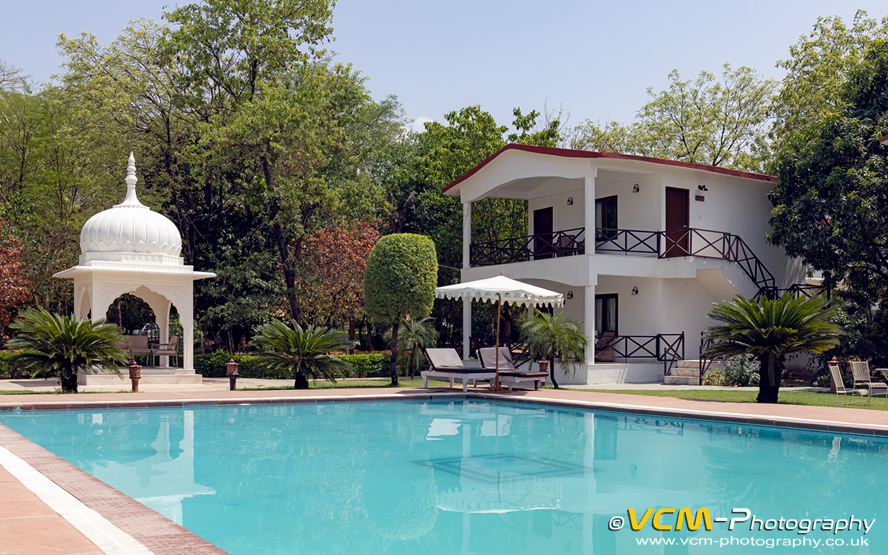 Our first‑floor Deluxe Cottage of the Tiger Den Resort overlooking the swimming pool.
Our first‑floor Deluxe Cottage of the Tiger Den Resort overlooking the swimming pool.
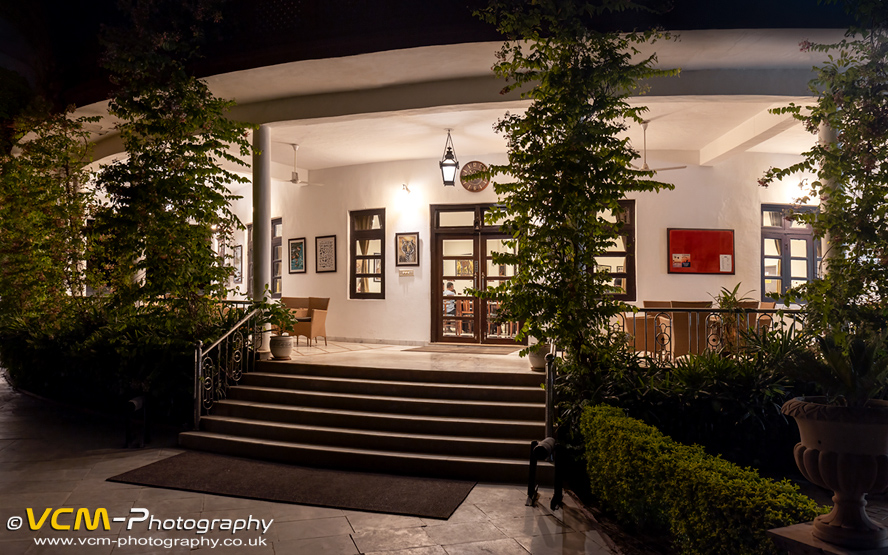 Entrance to the Tiger Den Resort multi‑cuisine restaurant.
Entrance to the Tiger Den Resort multi‑cuisine restaurant.
 The dining hall of the Tiger Den Resort multi‑cuisine restaurant.
The dining hall of the Tiger Den Resort multi‑cuisine restaurant.
For our sixteen jungle safaris we hired our own Suzuki Gypsy vehicle (the only permitted ones allowed in the park) and
naturalist/tracker.
Ranthambhore had introduced some new rules and regulations since our last visit. One of the rules was that jeeps could only turn around
and reverse their route at designated areas. This was to prevent too many jeeps congregating at a tiger sighting, or at least reduce
the time for a buildup of jeeps. This happened to us on a tiger sighting when the tiger started walking away from us in the direction we
had approached from. Normally we would just turn the jeep around and follow it. But this time we had to drive about five hundred metres
further along the road before we could turn around at a designated area. To enforce the new rules all the jeeps are monitored with
GPS trackers. Another new policy was that on a Tuesday only Zones 1 to 5 would be open, whilst Zones 6 to 10 would be closed. On a Wednesday
the policy was reversed with only Zones 6 to 10 being open, whilst Zones 1 to 5 would be closed.
Bala, our naturalist/tracker.
The itinerary for a typical day was as follows:
Up early (05:15) for our morning game drive, as the park opens at 06:00. A cup of coffee and some biscuits in the dining hall
helped wipe away the tiredness as we waited for our naturalist/tracker and his jeep driver to arrive. From the hotel it was only a
five‑minute drive to the park entrance, but could be longer depending on which zone we were allocated for the safari. At the entrance
to our allocated zone we had to show our passports. The passport details must match those of the original booking, otherwise access would
be denied. So if you received a new passport since making the booking it was important to bring your old passport with you. All jeeps had
to exit the park by 09:30 or the naturalist and driver could be fined or given a limited ban. We then returned to the hotel for a hearty
breakfast and had free time till lunch which was served from 13:00 to 14:30. After lunch we had more free time till the afternoon
safari which started at 15:00. Jeeps had to exit the park by 18:30 after which we returned to the hotel and relaxed till the evening
meal which was served from 19:30 to 21:30. After the evening meal we retired for the evening after a long exhausting but enjoyable
day.
Thursday 10th. Afternoon safari, Zone 2.
Entry and exit gate: Singh Dwar. Balveer Singh (Bala) our naturalist/tracker informed us that the tigress T‑84,
Arrowhead who had two eighteen‑month‑old cubs was struggling to hunt due to an injury or illness. In the morning a sambar deer
had died in the park and because of Arrowhead's injury the park rangers had moved the deer and given it to the cubs. We found the cubs
in a ravine feeding on the deer, but they were partially hidden from view and difficult to photograph. One of the cubs eventually walked
into an open area allowing me to quickly capture some photos. As more jeeps arrived at the sighting Bala suggested we go to look for the
tigress T‑105, Noorie whose territory was further on in the zone. As we were driving to the area a female sloth bear and cub crossed
the road in front of us and disappeared into the jungle. I was lucky to capture some photos as sloth bears tend to be relatively shy and
elusive. We eventually found the tigress T‑105, Noorie lying in a shaded area on a dry riverbed. She eventually started walking but
kept her distance by keeping to the far side of the riverbank. We followed her till it was time to exit the zone.
Friday 11th. Morning safari, Zone 10.
The entrance to this zone was about a twenty‑five‑to‑thirty‑minute drive from our hotel, through the old city of
Sawai Madhopur. This was our first visit to Zone 10, so it was refreshing to see a different area of the park. The only downside is that
the zone has a lower tiger population than the premier zones surrounding the fort and lake areas.
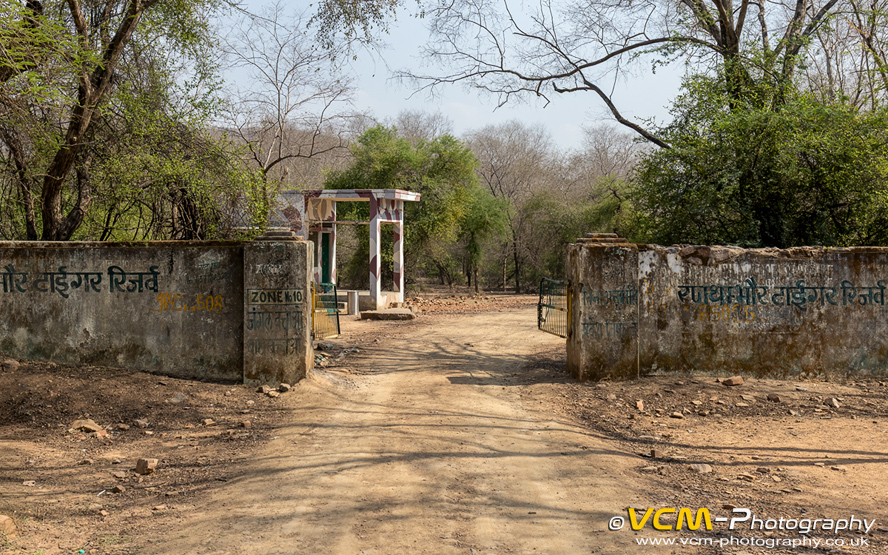 Entrance gate to Zone 10.
Entrance gate to Zone 10.
The zone was quite hilly with dhock trees and thick vegetation bordering the forest roads. There were only a few open meadows which greatly reduced the chance of a spotting a tiger unless you were lucky to find one walking on the road. We did find pugmarks of a large male on the road which had been patrolling his territory through the night. We followed the tracks but no tiger was seen, but we did witness two young male sambar deer practising rutting in the middle of the road. As we neared the gate to exit the zone a large sloth bear was walking on the road towards us. Normally they are quite shy and would run into the jungle, but this was a large confident male and he carried on walking towards us. We kept our distance by reversing the jeep, till we had to eventually park on the side of the road and allow him to pass. An excellent end to our morning safari.
 Two young sambar deer practising rutting.
Two young sambar deer practising rutting.
Friday 11th. Afternoon safari, Zone 4.
Entry and exit gate: Singh Dwar. A quiet safari with no predators seen. It was nice to see a spotted owlet in a tree by the lake which
was quite happy to pose for some photos. After we exited the zone, we started driving back towards the park main gate. As we approached the
Aadaa Balaji Temple the road was blocked by jeeps, as a tiger had been spotted in the tall grass by the roadside. I only caught a glimpse
of the tiger, a twenty‑month‑old cub of the tigress T‑107, Sultana, as it climbed up the rocky hillside and disappeared
into a cave.
Saturday 12th. Morning safari, Zone 1.
Entry and exit gate: Singh Dwar. This morning Bala was trying to find the fourteen‑year‑old dominant tigress T‑39,
Noor. He knew she was in the area but was probably resting somewhere hidden from view. Whilst at a forest checkpoint a jeep informed us that
a leopard had been spotted in a tree. We rushed to the area and found the leopard resting on the bough of a tree, approximately fifty metres
from the road. Other jeeps and canters were at the sighting, so we couldn't get in a position to get a clear view of it. Also it was
facing away from us, and the trunk of the tree was hiding its head, so we decided to leave. We returned to the area where we had been searching
for Noor and parked up next to a stream and waited. Soon we heard sambar deer warning calls and eventually spotted Noor walking on the hillside
approximately four hundred metres away. We hoped she would come down to the water to drink, but she lay down out of sight.
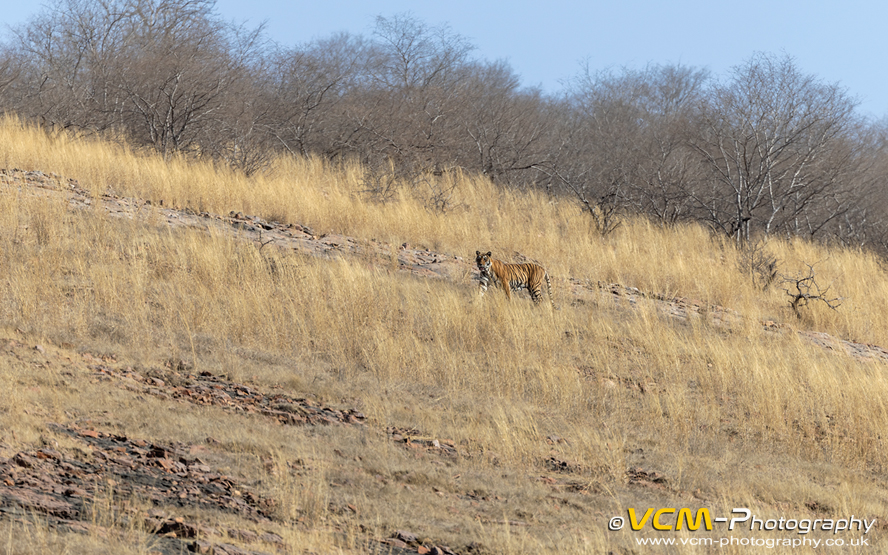 Tigress T‑39, Noor sighting in Zone 1.
Tigress T‑39, Noor sighting in Zone 1.
Returning to the gate we passed the leopard which was still in the tree. As there was only one other jeep at the sighting, we managed to get in an optimum position to take some photos where I could see its face.
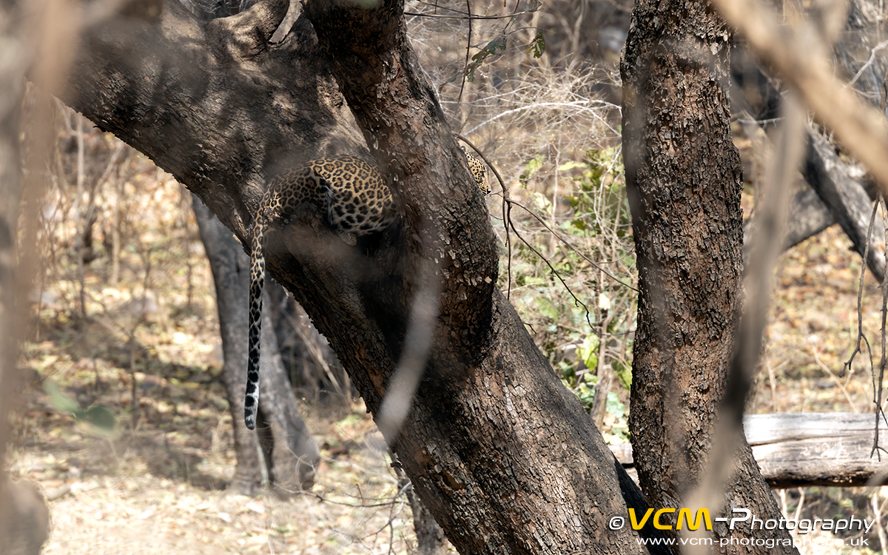 Leopard sighting in Zone 1.
Leopard sighting in Zone 1.
Saturday 12th. Afternoon safari, Zone 8.
The entrance gate to the zone is located between the new and old city of Sawai Madhopur. Like Zone 10, this was a zone we had never visited
before, so it was exciting to explore a new area. At the start of the safari the road routed along the bottom of an escarpment, till it started
to wind its way up a cutting in the escarpment onto the top of a high plateau.
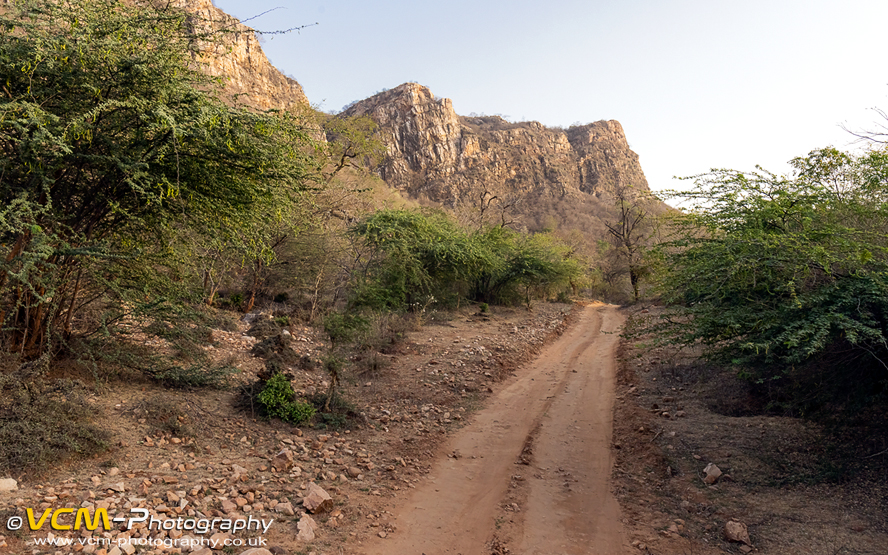 Road along the bottom of the escarpment in Zone 8.
Road along the bottom of the escarpment in Zone 8.
On top of the plateau which consisted mainly of grassland we had a panoramic view of the city and surrounding countryside below.
A tigress had been spotted in this area by a jeep on the morning safari, so we headed straight to the only waterhole on the plateau, parked up
and waited. While we were waiting spotted deer started to appear as they made their way onto the upland plateau for the evening.
They do this for safety as its easier for them to see a tiger up here during the night than in the dense jungle down below. Bala informed us
that tigers only come up onto the plateau to patrol their territory, because during the day there is not much prey and its too hot. We checked
the lowland areas before we had to exit the park with no tiger seen.
Sunday 13th. Morning safari, Zone 5.
Entry and exit gate: Singh Dwar. We travelled to the far end of the zone after we heard that during the evening a tigress had killed
a sambar deer by the river. We also learnt that a large male had driven the tigress off her kill and taken the prize for himself. When we
reached the area other jeeps had located the kill but could not see the tiger. The tiger could easily conceal itself in the bushes and tall reeds
bordering the river. On the opposite side of the river jeeps had congregated on a low escarpment which overlooks the area, and the occupants
had spotted something as they were pointing down to the area in front of us and getting excited, so we moved over there to have a look for
ourselves. Partially hidden in the tall grass was a large male tiger sleeping. It was still there when we had to leave.
Sunday 13th. Afternoon safari, Zone 2.
Entry and exit gate: Singh Dwar. For the last few days T‑124, Riddhi, the dominant tigress of the lakes had been up at the fort
with her cubs because they had been feeding on a sambar deer she had killed there. It was now known they had descended back onto the lowland
area around the lakes, se we headed to the area where Zone 2 borders with Zone 3. At the border of the two zones we cold see a commotion over
by the Padam Talab Lake as many jeeps had gathered. Obviously there was a sighting, but we couldn't see anything from our position.
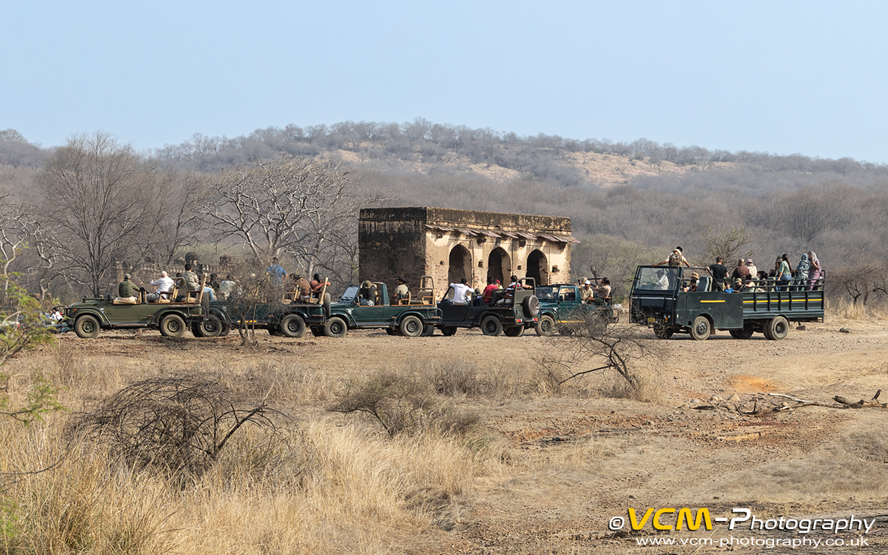 Tiger sighting by the Padam Talab Lake in Zone 3.
Tiger sighting by the Padam Talab Lake in Zone 3.
Bala suggested we go and look for the male tiger T‑101, Hades which had been seen earlier near the entrance to Zone 2. We visited the area but there was no sign of the tiger, so we returned to the area we keft earlier. When we returned to the area, we found one of Riddhi's cubs lying on the grass in the open about fifty feet away, oblivious to all the jeeps which had gathered at the sighting. The cub approximately twenty‑month‑old eventually got to his feet, walked a short distance before settling down again and falling asleep. We now had to make a dash to the exit gate as we only had fifteen minutes before it closed. As luck would have it, as we were driving down the rocky road alongside the bottom of the fort the male tiger T‑102, Hades was spotted lying on the embankment overlooking the road. I only had seconds to quickly take a photo as time was running out. We exited the zone and started driving along the paved road towards the main entrance. As we approached the Aadaa Balaji Temple jeeps were congregating in the area again, as a tiger had been spotted emerging from a cave on the rocky hillside and climbed down and disappeared into the long grass by the road. Eventually the tigress T‑107, Sultana emerged from the grass, crossed the road between the parked jeeps and climbed up onto a ledge on the opposite cliff where she posed for a few seconds before disappearing into another cave. An amazing sighting. Not the best sighting for photography as the area was in deep shade and the light was beginning to fade, but I wasn't complaining.
 View of the Aadaa Balaji Temple when entering the park in the afternoon.
View of the Aadaa Balaji Temple when entering the park in the afternoon.
Monday 14th. Morning safari, Zone 7.
Another zone we had not visited before and another long drive to the entry gate which required passing through the old city of
Sawai Madhopur. We travelled to the far end of the zone where we saw some tiger pugmarks. We searched the area but heard no warning calls,
so we slowly started to make our way back to the exit.
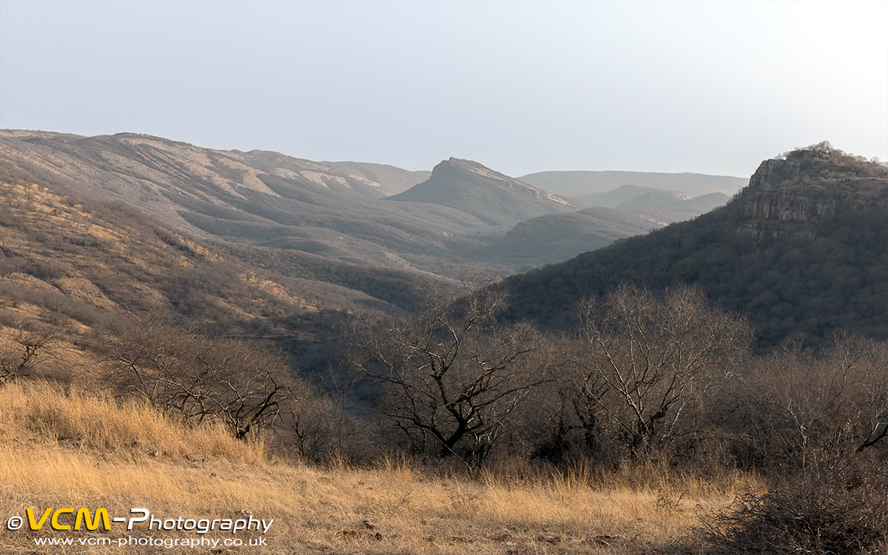 Scenic view of Zone 7.
Scenic view of Zone 7.
Making our way to the exit we came across another jeep which had just seen a leopard in the valley below the road. We went down into the valley to investigate as there was a waterhole down there. We waited ten to fifteen minutes but nothing appeared, so we started to drive up the hill out of he valley when a leopard crossed the road in front of us and walked into the jungle. The leopard, a large male stopped and watched us from a distance, but seemed reluctant to move‑on and kept looking back towards the road. The reason soon became apparent when a female leopard suddenly crossed the road behind us and joined the male. I managed to get some photos of the male, but it was very difficult due to the thick vegetation blocking my view. By using spot autofocus I managed to focus on the leopards eyes and get a sharp image. The mating couple climbed higher up the hill till we lost sight of them. A very lucky sighting considering the lack of open spaces and density of the jungle.
 Mating pair of leopards in Zone 7.
Mating pair of leopards in Zone 7.
After we exited the park and were driving through the old city of Sawai Madhopur we approached a group of jeeps blocking the road. The occupants and even the locals were looking and pointing towards the hill which overlooks the area. Apparently a leopard had been spotted on the rocks near the summit. Scanning the area with my camera I couldn't see anything.
 Possible leopard sighting on the hill overlooking the old city of Sawai Madhopur.
Possible leopard sighting on the hill overlooking the old city of Sawai Madhopur.
Monday 14th. Afternoon safari, Zone 5.
Entry and exit gate: Singh Dwar. A quiet safari with no predators seen, but we did get a good sighting of a brown fish owl which was
perched in a tree overlooking the road.
Tuesday 15th. Morning safari, Zone 5.
Entry and exit gate: Singh Dwar. Driving towards the entry gate on the paved road a sloth bear suddenly emerged from the bushes onto
the road in front of us. A couple of locals on a scooter had to break hard to avoid it, nearly falling off. Surprised and probably feeling
threatened the sloth bear reared up on its huind legs in a defensive posture, growled and bolted off back into the forest. A lucky encounter
for the pair on the scooter.
Soon after entering the zone we heard monkey warning calls. We checked the area, but nothing was seen. We concluded that it was probably
a leopard as this was an area suited to them. Driving further into the zone we heard sambar deer warning calls, so we stopped and waited.
Sambar deer warning calls started coming from further afield which indicated that the predator was on the move. We checked the local waterholes
but nothing was seen. Passing the area where there was probably a leopard earlier in the morning we heard sambar deer warning calls. We
observed one of the sambar deer making the alarm calls and could see where it was looking, but we could see no predator. They were still
making alarm calls when it was time for us to leave.
Tuesday 15th. Afternoon safari, Zone 1.
Entry and exit gate: Singh Dwar. We travelled to the far end of the zone because it was believed the tigress T‑39, Noor was
in the area. We heard a sambar deer warning call, but nothing was seen. The jungle was relatively quiet, so we decided to leave early.
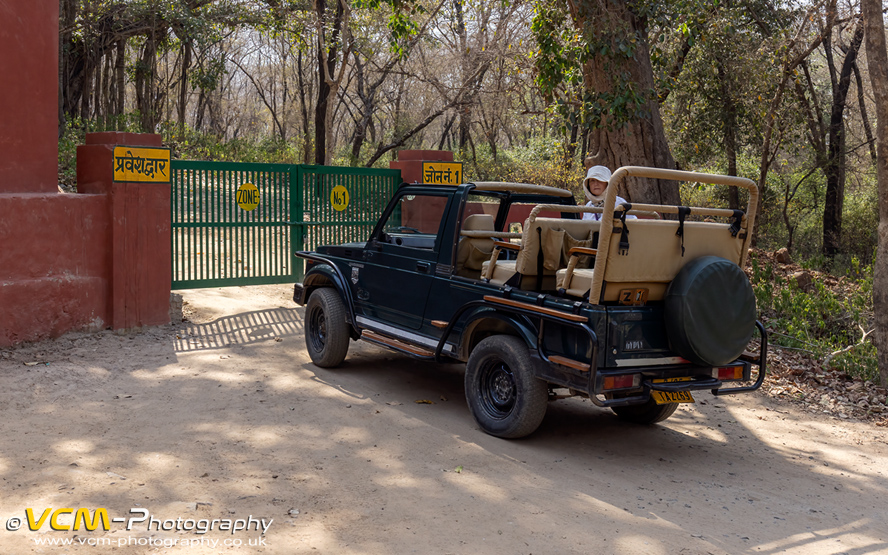 Waiting at the entrance gate to Zone 1 for our afternoon safari.
Waiting at the entrance gate to Zone 1 for our afternoon safari.
Wednesday 16th. Morning safari, Zone 6.
Another zone we had not visited before and another long drive to the entry gate which required travelling through the old city of Sawai
Madhopur. Bala had been informed that the tigress T‑39, Noor had entered the zone the previous evening from Zone 1, so we headed to
the area bordering the two zones. We soon found fresh pugmarks on the road and then heard a chital alarm call, quickly followed by a monkey
alarm call. We stopped and waited and it wasn't long before the tigress appeared. She was approximately forty metres away walking parallel
to the road, surely heading towards Zone 1. She stopped to drink at a waterhole before laying down in the shade of a tree. She was still there
when it was time for us to leave.
Wednesday 16th. Afternoon safari, Zone 10.
A long drive to the entry gate which required travelling through the old city of Sawai Madhopur. While waiting at the gate to get our documents
checked, Bala gave us some sad news. He had been informed that a seven‑year‑old boy had just been killed by a tiger while visiting
the Trinetra Ganesh temple within Ranthambhore National Park with his family. He had no further information on the incident.
After entering the zone we searched all the waterholes, but there was no indication of the presence of a predator, so we started driving back
towards the exit gate. Driving towards the exit gate we came across jeeps and canters gathered on the bank of a dry rocky riverbed ‑
a sighting. Approximately sixty metres away, partially hidden in a waterhole was the fourteen‑year‑old tigress T‑8, Ladali.
The park authorities were beginning to think she had died as she had not been seen for over four months. We were lucky with the sighting because
she had only emerged from the jungle and entered the water three minutes before we arrived. We could have easily driven past the area without
seeing her. She eventually got out of the water and started climbing the steep hill above the dry riverbed till we lost sight of her.
After exiting the park and nearing our hotel, a striped hyena crossed the road in front of us and disappeared into the scrubland bordering
the road. A very rare sighting, but one which caught me off‑guard. I managed to get some photos, but they were terribly underexposed as
it was starting to get dark.
 Tigress T‑8, Ladali sighting in Zone 10.
Tigress T‑8, Ladali sighting in Zone 10.
Thursday 17th. Morning safari, Zone 2.
Entry and exit gate: Singh Dwar. We had only been in the zone ten minutes when we found the tigress T‑124, Riddhi resting on a
concrete bridge crossing a river. She soon got up and walked away. We left the area and followed the road as it climbed up the hill bordering
the fort towards Zone 3. There was no sign of any tigers, so we travelled to the opposite end of the zone to see if we could find the tigress
T‑105, Noorie. Again there was no sign of any predators, so we travelled all the way back to the area bordering Zone 3. At the border
of the two zones we could see many jeeps gathered over by the Padam Talab Lake. Obviously there was a sighting. From our location we could see
between a group of jeeps a tiger laying down on the ground next to the ruins of a building. The tiger which was one of Riddhi's cubs
eventually started walking and moved out of sight, with all the jeeps following. We quickly moved position hoping the tiger would come into our
zone. We waited till it was time to exit the zone. As we were driving down the hill which borders the fort, we saw a jeep slowly driving towards
us. We suddenly realised the tigress T‑124, Riddhi was walking in front of it towards us. For the next five minutes we had an amazing
sighting as we kept reversing the jeep to keep our distance as Riddhi walked towards us. We eventually pulled over to the side of the road
and allowed the tigress to pass, as we had to quickly make our way to the exit.
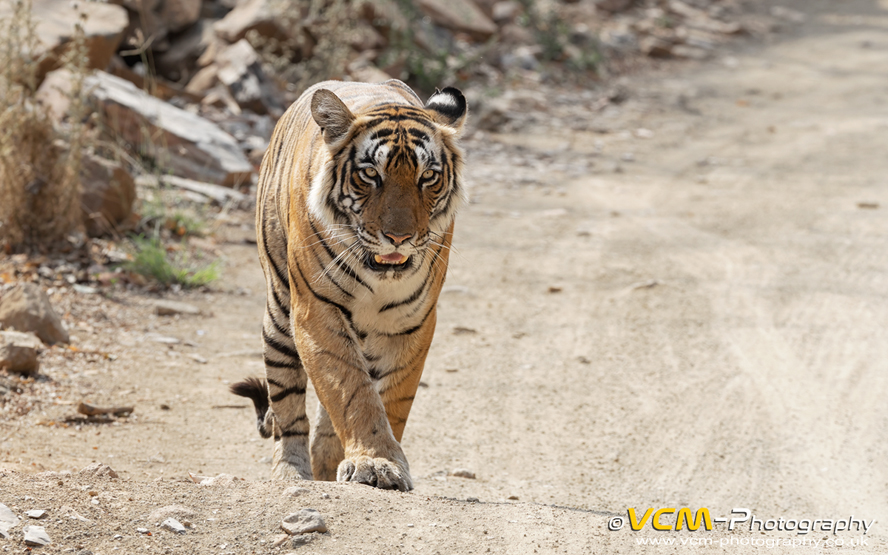 Tigress T‑124, Riddhi sighting in Zone 2.
Tigress T‑124, Riddhi sighting in Zone 2.
Thursday 17th. Afternoon safari, Zone 5.
Entry and exit gate: Singh Dwar. A quiet safari with no alarm calls or predators seen, but we had a nice sightings of a shikra
and a brown fish owl.
Friday 18th. Morning safari, Zone 5.
Entry and exit gate: Singh Dwar. Our last safari. We checked all the waterholes. A canter had a glimpse of a tiger in an area we did
not have access to. We waited in the area where Zone 5 borders Zone 4, but no alarm calls were heard or predators seen before we had to
exit the zone.
Returning to the Tiger Den Resort we bid farewell to Bala and thanked him for looking after us and showing us some wonderful wildlife
sightings. We had breakfast before returning to our cottage in preparation for checking out in the afternoon. After lunch we thanked the hotel
staff and boarded our taxi for the journey back to New Delhi Indira Gandhi International Airport, where we caught our Sunday 01:35 flight
back to the U.K.
Photographs from my trip can be viewed at:
2025 ‑ Ranthambhore, India.










